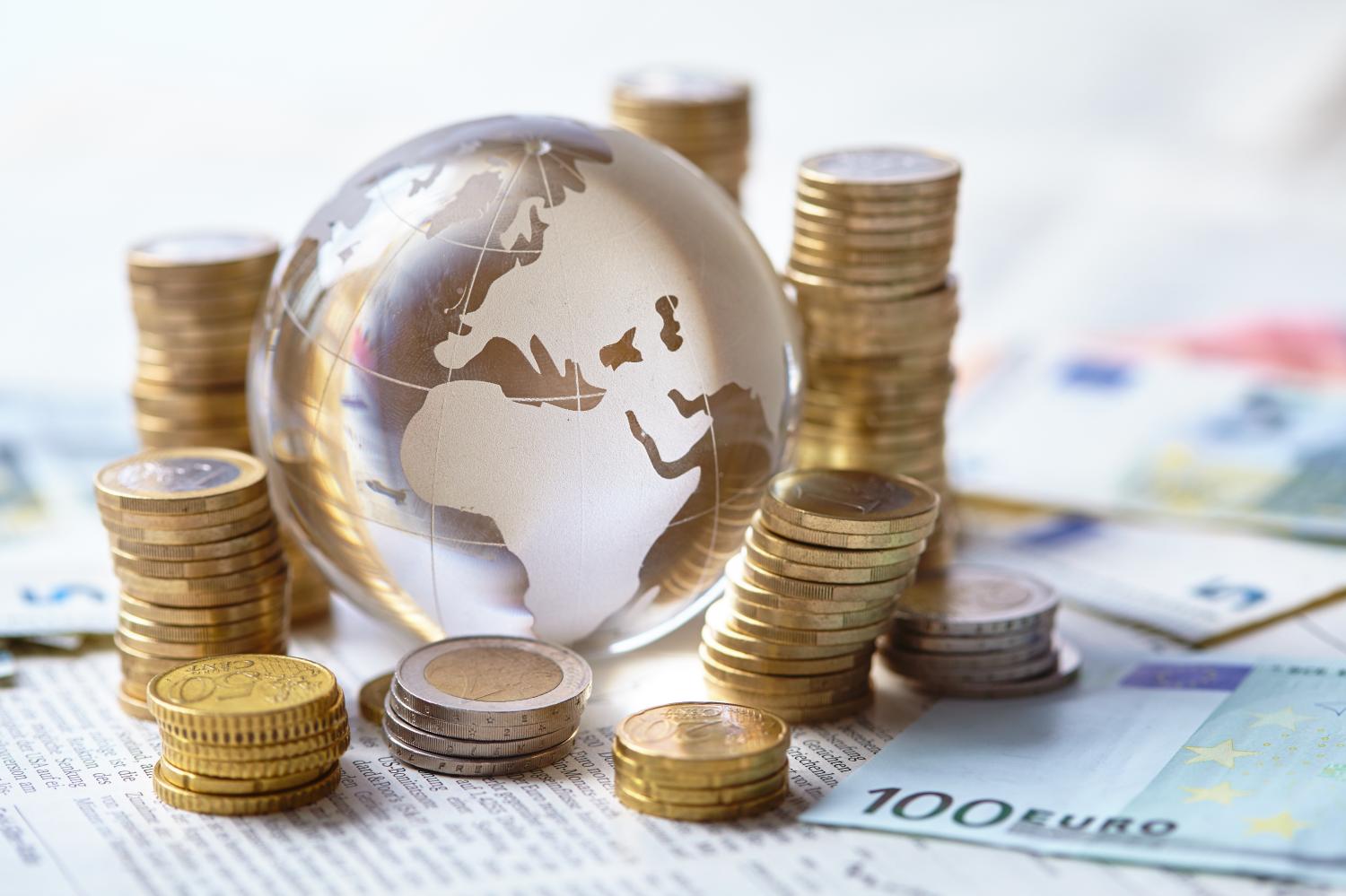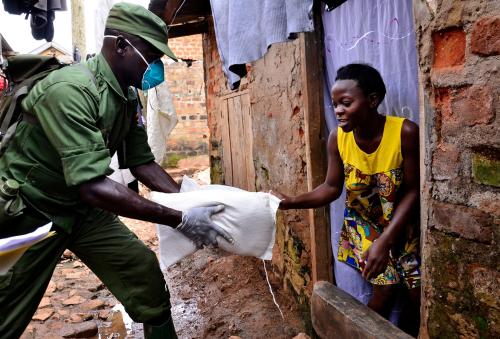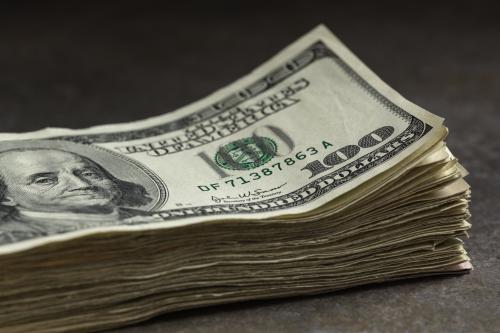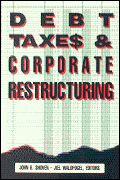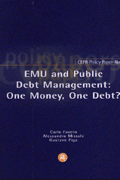Background
The sharp global recession now expected in 2020 (negative 5.9 percent GDP per capita according to the IMF) coupled with devastating actual and potential loss of life and health damage due to COVID-19 has left the global macroeconomic and development playbook in tatters. Countries have announced $11 trillion in new fiscal measures to mitigate the impact and this figure will surely rise as additional stimulus packages get tabled.1
Governments in major advanced economies have found they can raise finance on domestic capital markets without adverse impact on inflation or on the cost of capital. In several cases, there appears to be a “free lunch” being served by savers prepared to receive negative real interest rates in exchange for principal security and liquidity. Estimates of the size of sovereign bonds with negative real rates exceed $10 trillion.2 On average, government spending in rich countries has risen by over 13 percentage points of GDP, and the public sector has provided a similar amount in loans and guarantees, totaling a 26.5 percentage point increase in public debt.3
The situation is more nuanced, and unpredictable, for emerging and developing economies, especially those with thin domestic financial markets. For these countries, most additional financing must come from abroad. The question at the heart of this paper is “where will the money come from to respond, restore and reset programs for sustainable development?” The answers lie in an assessment of international financing instruments.
There are three clear phases in the economic response to COVID-19. First, there is an immediate response to save lives. Countries must manage the health crisis by expanding public health services and flattening the curve to avoid overburdening hospital capacity through lockdowns, social distancing, and clear communication to the public of their social responsibilities. Second, there are steps to restore livelihoods and mitigate the socio-economic impact of the crisis and the multiple global economic shocks of falling commodity prices, trade, tourism, remittances, and, in some cases, capital flight, along with major losses in jobs and wages. Third, there is a “build back better” agenda of resetting growth along a path of improved sustainability, inclusion, and resilience.
Each of the three phases has distinct requirements for public spending and, in the context of falling revenues, for public deficit financing. The health requirements of purchasing protective equipment, therapeutics, diagnostics, vaccinations (when available), and deploying armies of contact tracers and other professionals are sizable. The mitigation steps of protecting individuals from falling into destitution, avoiding business bankruptcies, safeguarding the financial sector against bad loans, protecting the country reputation for creditworthiness and preserving market access are a major expense both above the line of fiscal deficits and below the line with guarantees and public sector loans and equity infusions. Mitigation needs a fast infusion of public funds, which argues in favor of using existing spending mechanisms like social assistance programs. “Build back better” offers the promise of very high returns from investments that are intentionally sustainable, that are labor intensive, and that have high fiscal multipliers. Projects that accelerate a green transition and that strengthen safety nets and health and education systems fall into this category.
The common thread is that in each phase the economic, social, and environmental returns to public spending vastly outweigh the financial costs of financing, at least in countries with reasonable governance and implementation capabilities, and access to capital at reasonable cost. There is by now a deep literature on fiscal multipliers in developing countries, that documents the magnitude of the short-term impact on GDP and jobs, as well as the medium-term impact of lower energy costs, accelerated innovation and learning, and well-known spillovers from better health and education among citizens.
With most countries today finding themselves in a Keynesian moment in which they can implement the practical experiences of effective public programs, the problem has become one of finding the funds to expand public spending, rather than coming up with new ideas for sound public projects.
Some developing country governments have been able to access off-shore dollar bond markets at reasonable rates: Mexico raised $6 billion in April; Egypt $5 billion in May with market access buttressed by strong support from multilateral and bilateral creditors.4 Other countries are in the queue for 2020, including Cote d’Ivoire, Turkey, and South Africa. According to the IMF, emerging market economies are likely to add 5.5 percentage points of GDP to their fiscal deficits, and 6.8 percentage points to their public debt levels, in 2020.5
Most developing countries, however, especially those below investment grade, are abandoning plans to access global capital markets. Countries that are participating in debt standstill programs, or hope to participate in these programs, are committed to abstaining from new non-concessional debt. Cameroon, Ethiopia, Kenya, Nigeria, and Pakistan are among large developing countries falling into this category. These countries, on average, are keeping their plans for additional fiscal deficits at below 2 percentage points, thereby keeping public debt levels from rising by more than 3 percentage points.
These plans show a large shortfall compared to estimates of needs. The IMF and UNCTAD independently suggested around $2.5 trillion would be needed for developing countries to respond to the pandemic and associated economic shocks.6 The existing international financing architecture provides only a fraction of this. As of July 2020, the IMF had committed about $250 billion to 102 countries.7 The World Bank Group has announced its willingness to commit $160 billion over 15 months.8 Even allowing for other multilateral development banks and agencies, the developing world faces a potential shortfall of close to $2 trillion.
For this reason, several proposals have been made for innovations that could potentially raise large amounts of financing for development. Some require a political push for more generosity from rich countries, often coupled with financial engineering to maximize impact, while others require reforms in the international economic system that would permit developing countries to mobilize resources by and for themselves.
This paper seeks to review the more promising proposals in a systematic way. We have limited the selection of proposals to those that are (i) already being discussed in official policymaking circles; and (ii) are large enough to have a material impact given the scale of the identified gap. Our purpose is to summarize enough of the details to permit the reader to understand what each proposal can and cannot do, and where the political sticking points might lie. Our hope is to contribute to a more informed discussion of how to move forward and where to focus efforts for advocacy.
Before starting, one fundamental point requires clarification. There are two global problems that need to be solved. One is avoiding unnecessary suffering and deaths in developing countries. There is a serious risk that because lockdown policies are economically costly and can generate prolonged debt crises, developing country governments might rationally choose to be less aggressive on the health front, and to accept higher deaths, with spillovers to other countries trying to contain the pandemic.9
A second problem is that capital in the global economy is being misallocated on a massive scale, and this inefficiency has high costs that can be ill-afforded at this time. The issue is the presence of a “debt overhang” in many developing countries. When a new creditor lends to an indebted government, it joins the queue of other creditors to get repaid, especially for general purpose lending. If the government is already facing debt service troubles, then the new creditor, too, may not be repaid on schedule even if the new project it finances yields a high return that is higher than the cost of funds. In domestic capital markets, this type of problem is overcome through first settling old debt claims in bankruptcy or other voluntary debt restructuring processes based on existing assets, before the new creditor adds additional assets to the company. But there is no equivalent in international capital markets, so “debt overhang” problems can persist. This prevents the efficient allocation of new capital and is costing three groups of people very dearly: those within developing countries who needlessly suffer when public spending is restrained, existing creditors who will suffer from the inability of a country to implement high return spending, and new investors who have to seek returns in other markets usually offering far lower interest rates.
The next section of this paper looks at financing proposals that could potentially expand fiscal space in developing countries. Even though it is well understood that the vast majority of spending to build back better will come from domestic resource mobilization, including in developing countries,10 we focus here on international resource flows because most developing countries do not have the liquidity to tap local currency markets to a significant degree, and because there are limits in the short- to medium-run on their ability to raise more taxes. They should pursue the longer-term tax and capital market development reforms, but the response over the next couple of years will depend on access to foreign capital.
Section III expands the discussion of public financing to include how private sector financing could be better deployed. A final section offers summary assessments of scope, timeliness, and political will to advance the proposals.
-
Footnotes
- IMF. 2020. “World Economic Outlook Update.” June 2020.
- Eisen. 2020. “Negative-Yielding Debt Tops $10 Trillion.” The Wall Street Journal, June 2.
- Gasper and Gopinath. 2020. “Fiscal Policies for a Transformed World.” IMF Blog.
- Reuters. 2020. “Mexico launches $6 billion, three-part U.S. dollar bond offering.” April 22; Magdy. 2020. “Egypt Sells $5 Billion Eurobond in Its Largest-Ever Issuance.” Bloomberg, May 21.
- Gaspar and Gopinath. 2020.
- Georgieva. 2020. “Opening Remarks at a Press Briefing by Kristalina Georgieva following a Conference Call of the International Monetary and Financial Committee (IMFC).” IMF, March 27; UNCTAD. 2020. “UN calls for $2.5 trillion coronavirus crisis package for developing countries.” March 30.
- IMF. 2020. “Covid-19 Financial Assistance and Debt Service Relief.” July 29.
- World Bank. 2020. “World Bank Group: 100 Countries Get Support In Response to COVID-19 (Coronavirus).” Press Release, May 19.
- Arellano et al. 2020. “Deadly debt crises: COVID-19 in emerging markets.” NBER Working Paper 27275.
- Kharas and McArthur. 2019. “Building the SDG economy.” Brookings Institution Report.


